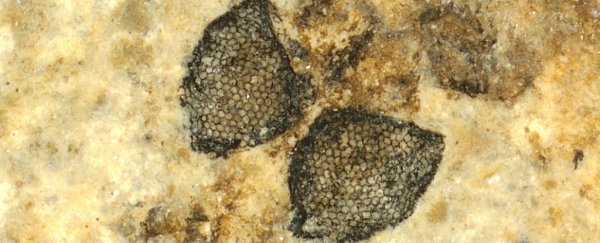Around 54 million years ago, in the early Eocene, there lived a tiny crane fly. It may not have been a particularly remarkable crane fly while it was alive, but after it died, geological processes turned it into something magnificent: a fossil so brilliantly preserved, we can make out the individual cells of its compound eyes.
Now scientists have analysed these ancient eyes - and those of 22 of its contemporaries, also preserved in the fossil beds of Denmark - and found the earliest evidence of melanin pigment ever seen in arthropod eyes.
The compound eye is the most common form of eye found on the planet, and we can date it back over half a billion years. As early as 515 million years ago, ancient arthropods were viewing the world through hexagonal segments called ommatidia.
In these ommatidia, natural pigments shield the photoreceptor at the back of the eye from light entering outside the field of vision, optically separating the cells and increasing contrast perception.
Most vertebrates have melanins in their eyes for this purpose, but arthropod eyes are different. Today's arthropods have pigments called ommochromes as this light screen. But in those ancient fossilised specimens, no ommochromes have been detected.
So, molecular palaeobiologist Johan Lindgren of Lund University and colleagues went looking, using a collection of exceptionally well preserved fossilised crane flies (exact taxonomy yet to be determined), excavated from the Fur Formation in Denmark specifically for this research.
The team used a number of techniques to analyse the fossils in detail, including scanning electron microscopy and X-ray spectroscopy.
 (Lindgren et al., Nature, 2019)
(Lindgren et al., Nature, 2019)
To study the molecular composition of the facet walls of the eye, they used time-of-flight secondary ion mass spectrometric (ToF-SIMS) analysis. The data obtained from these spectra were then compared against a number of compounds, including samples of an ommochrome called xanthommatin.
Oddly, the samples matched more closely with the team's samples of a pigment called eumelanin. So, they subjected their fossils to an assay designed to detect melanins. This recovered low but detectable amounts of several breakdown products of melanin oxidation.
Part of the research was comparing the fossils to modern crane flies. The eyes of approximately 1,300 lab-raised tiger crane flies (Nephrotoma suturalis) were isolated and analysed. Once again, these produced breakdown products unique to eumelanin.
"Our discovery of eumelanin in corresponding examples of a fossil and living insect contradicts the widely accepted hypothesis that melanic screening pigments are absent in the compound eyes of arthropods," the researchers wrote in their paper.
"Our inability to detect equivalent molecular traces of ommochromes in the fossil crane flies - together with the apparent sensitivity of these pigments to experimental degradative treatments - implies that ommochromes are unlikely to survive across geological time.
"We therefore propose that the dark colouration that is occasionally seen in the head region of other fossil arthropods also represents residual eumelanins."
 (Lindgren et al., Nature, 2019)
(Lindgren et al., Nature, 2019)
There's one more cool discovery. The lenses in the compound eyes of the trilobite have long been thought to have calcified while the animal was alive. But the lenses of the team's fossilised crane flies also showed evidence of calcite.
Modern flies, however, have chitin lenses - the same stuff from which their bodies and wings are made. And this calcification would compromise their vision if it was occurring while they were still living.
The researchers propose that the calcification is instead something that happens during the fossilisation process.
"Thus," they wrote, "we conclude that the long-standing hypothesis of calcitic corneas in trilobites requires reconsideration, and that the composition and optic properties of their compound eyes should instead be viewed as akin to those of modern arthropods in being primarily organic."
The research has been published in Nature.
